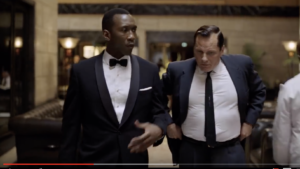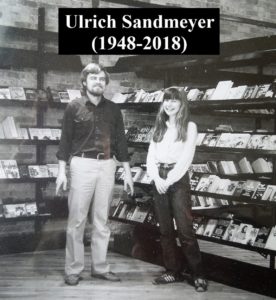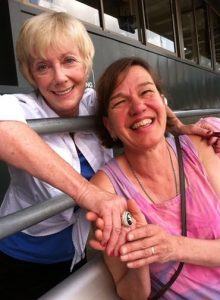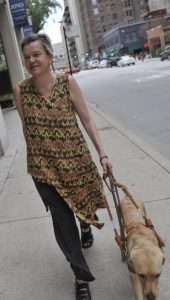Hey, Hey, Hey, Hello: my StoryCorps interview with Nancy Faust airs this Friday, March 15
March 13, 2019 • 8 Comments • Posted in baseball, blindness, memoir writing, Mike Knezovich, radio, travelRemember when I wrote that post last September about recording a StoryCorps interview with renowned baseball organist Nancy Faust? It’s going to air this Friday morning, March 15, 2019 on WBEZ in Chicago!

That’s me celebrating with Nancy at Half Sour (our local tavern) after recording the interview last year. (Photo: Joe Jenkins.)
The timing is perfect: Mike, Seeing Eye dog Whitney and I are flying to Arizona tomorrow to stay with Nancy and Joe for a few days. Their son Eric and his girlfriend Ann will be there, too, and we’ll all head to Camelback Ranch on Friday to be at Nancy’s one-day return to the baseball organ bench: She’s performing at Friday’s Cubs-Sox Spring Training game!
The baseball field at Camelback Ranch does not have a baseball organ, but Nancy says that’s no problem: with the help of her sweet husband Joe Jenkins, she will bring her own. “They changed the spot for the organ and asked if we could deliver it Thursday instead of today,” she wrote me in an email message this morning. “So we arranged for a 10 a.m. delivery and can easily get to the airport when you arrive.” Now, tell me: How many people do you know who have baseball organist friends who pick them up at the airport, and, when necessary, bring their own instrument from home to play at the ballpark?
My relationship with Nancy Faust started on a bittersweet day –- the day my eye surgeon told Mike and me that none of the surgeries they tried had worked, From my memoir, Long Time, No See:
The White Sox were in town that day. Going to a ballgame after learning I’d be blind for the rest of my life was probably a strange thing to do, but it beat heading home and sitting on our pitiful second-hand couch and wondering where to turn next.
The White Sox were having a rotten year. There were maybe 8,000 people in the stands. Floyd Bannister pitched, the Sox lost. But it was strangely pleasant, sitting next to Mike with my head up, not giving a thought to eyes or surgery. We each had a bratwurst and a beer. Between bites and gulps and giving me play by play, Mike bantered with other fans, cursing the underachievers on the team. I laughed at the tunes selected by Nancy Faust, the Sox organist–she’s famous for picking songs that play on player’s names. Mike marveled at the endurance of Carlton Fisk, and we both wondered out loud why every time we went to a game, that bum Bannister was pitching.
When Nancy Faust was at the organ and a player walked, you might hear Johnny Cash’s “I Walk the Line.” If there was a pickoff throw, she’d likely play “Somebody’s Watching me.” And when the pickoff was successful? The Kinks’ “You Really Got Me.” Nancy was also at the organ when Harry Caray first sang “Take me out to the ballgame” for the seventh-inning stretch at Comiskey Park. And she was the first to play “Na, na, na, nah, na, na, na, nah, hey, hey, hey, goooodbye!” when the opposing pitcher got sent to the showers.
She always helped me know who was batting by teasing the player’s name with a tune. Some of Nancy’s choices were obvious — Dave Brubeck’s “Take Five” for players with that number, the theme from “Magnificent Seven” for players sporting number seven on their backs. Nancy invented walkup music, and to my mind, she was better at choosing songs than today’s players are.
I stopped by Nancy Faust’s booth at White Sox Park after Long Time, No See was published in 2003 to sign a copy for her. I was tickled to have an opportunity to thank her personally for helping me track what’s happening on the field, and we’ve been friends ever since.
Mike’s all-time favorite Nancy Faust walk-up tune is the one she’d play for Gary Disarcina. No, it wasn’t “Gary, Indiana” from the Music Man. That is wayyyy too obvious. It was “Have you Seen Her?” by the Chi-Lites.
As for me, I used to think Nancy was at her best whenever Travis Hafner was in town. At a game against the Cleveland Indians, she played “Bunny Hop” for his first at bat, and then J. Geils “Centerfold” his next time up. During our StoryCorps interview she told me that when a streaker once jumped from the stands and ran across the outfield, she played, “Is That All There Is?” That’s my new fave.
The interview she and I did last September was 45 minutes long. The one that airs Friday will be five minutes, tops, but I’m hoping/expecting they’ll leave some of the parts in where she explains where she comes up with all these ideas. Chicago Tribune Sports writer Phil Rosenthal said it perfectly in the opening to his Monday column, where he alerts fans to cue the fanfare for the comeback at the March 15 Spring Training game: “It’s a big week for one of the greatest, most consistent, versatile and innovative players in Chicago sports history,” he says. “That, of course, would be Nancy Faust.”





